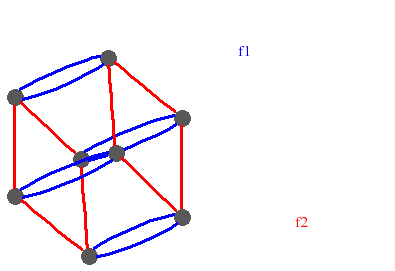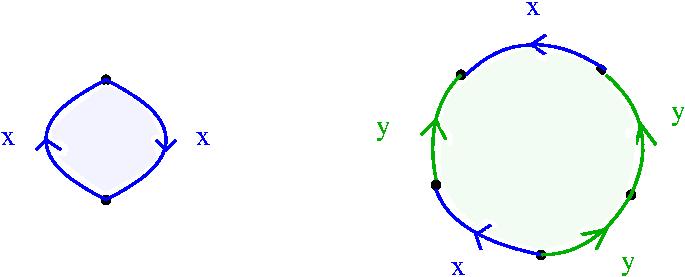| Previous |
About HAP: Second Homotopy Groups of
Presentations And A Periodic Resolution |
next |
- W. Bogley and S.J. Pride, "Calculating generators of Pi2",
in
Two-dimensional homotopy and
combinatorial group theory (edited by C. Hog-Angeloni, W. Metzler and
A.J. Sieradski), LMS Lecture Note Series 197 (1993), 157-188.
- R. Brown and J. Huebschmann, "Identities among relations", in Low dimensional topology (edited by R. Brown and T.L. Thickstun), LMS Lecture Note Series 48 (1982), 153-202.
For presentations P defining a small group G the structure of the module Pi2(KP) can be determined using the HAP function ResolutionSmallFpGroup(G,n) . This function inputs a finitely presented group G and integer n>2. It returns n terms of a ZG-resolution R arising as the cellular chain complex of a space X where: X is contractible; X admits a free cellular action of G; the 2-skeleton X2 is the universal cover of the space KP. Standard properties of the universal cover and the Hurewicz Theorem yield ZG-isomorphisms
Pi2(KP) = Pi2(X2) = H2(X2,Z) = Image( R3 → R2 ). |
The article by Bogley and Pride mentioned above explains how the theory of Igusa's pictures can be used to find generators for the module of identities of the standard presentation P = < x,y | x2, y4, xyxy > of the dihedral group D4. This example can also be handled using the following commands.
gap> D_4:= F / [ x^2, y^4, (x*y)^2 ];;
gap> R:=ResolutionSmallFpGroup(D_4,3);;
gap> RankOfIdentityModuleOverZ:=
( R!.dimension(2) - R!.dimension(1) + R!.dimension(0) )*Order(D_4) - 1;
15
gap> NumberOfGeneratorsOfIdentityModuleOverZG:=R!.dimension(3);
4
gap> #The four ZG-module generators are:
gap> for i in [1..4] do
> Print("\n Generator ", i, "=\n "); PrintZGword(R!.boundary(3,i),R!.elts);
>od;
Generator 1=
( - x*y^2 + y^2 )E1
Generator 2=
( - x + x*y )E2
Generator 3=
( - <identity ...> + x*y )E3
Generator 4=
( - <identity ...> - x*y - y - x*y^2 )E1 + ( - <identity ...> - x )E2 +
( + <identity ...> + x + x*y*x + y*x )E3

The function certainly works for groups larger than D4. For instance, the following commands take a couple of minutes to show that the standard presentation of the dihedral group D200 of order 400 also has a module of identities generated by four elements. (No doubt there's a theorem here!)
gap> D_200:= F / [ x^2, y^200, (x*y)^2 ];;
gap> R:=ResolutionSmallFpGroup(D_200,3);;
gap> R!.dimension(3);
4
- The presentation P = < x,y | x2, y3,
(xy)2 > of the symmetric group S3 was
considered in [R. Brown and A. Razak Salleh, "Free crossed resolutions
of groups and presentations of modules of identities among relations", LMS J. Comput. Math., (1999),
28-61] where covering groupoid techniques were used to show that the
ZG-module Pi2(KP) can be generated by four
elements. The following commands show that, in fact, it can be
generated by three elements. (Subsequent commands will show that
the module can even be generated by two elements.)
- A conjecture of Salvetti (mentioned on a previous page) would imply that the module of identities Pi2(KP) for the Coxeter presentation P = < x,y,z, | x2, y2, z2, (xy)3, (yz)3, (xz)2 > of S4 can be generated by no fewer than 10 elements. The following commands show that, in fact, it can be generated by six elements.
gap> F:=FreeGroup(2);;x:=F.1;;y:=F.2;;
gap> S_3:=F/[ x^2, y^3, (x*y)^2 ];;
gap> R:=ResolutionSmallFpGroup(S_3,3);;
gap> R!.dimension(3);
3
gap> #EXAMPLE 2
gap> F:=FreeGroup(3);;x:=F.1;;y:=F.2;;z:=F.3;;
gap> S_4:=F/[x^2, y^2, z^2, (x*z)^2, (y*z)^3, (x*y)^3];;
gap> R:=ResolutionSmallFpGroup(S_4,3);;
gap> R!.dimension(3);
6
gap> G:=F/[ x^2, x*y*x^-1*y^-2 ];;
gap> Order(G); IsAbelian(G); #Test that G really is isomorphic to S_3.
6
false
gap> R:=ResolutionSmallFpGroup(G,9);;
gap> for i in [1..9] do Print(R!.dimension(i),"\n"); od;
2
2
1
1
2
2
1
1
2
gap> R!.boundary(5,1)=R!.boundary(9,1);
true
gap> R!.boundary(5,2)=R!.boundary(9,2);
true
The periodic ZS3-resolution arises as the cellular chain complex of a contractible CW-space X on which S3 acts freely. An analysis of the boundary maps in the resolution yield the following explicit description of the orbit space B=X/S3 in low dimensions.
This classifying space B has a unique 0-cell and two 1-cells which we label by x and y. It has two 2-cells which are attached to the 1-skeleton according to the following pictures.

The space B has one 3-cell attached to the 2-skeleton according to the following picture.

This last picture corresponds to an identity between the relators r:=x2 and s:=xyx-1y-2 and represents a map S2 → B2 from the 2-sphere to the 2-skeleton of B. This kind of map is called a homotopical syzygy in the paper [J.-L. Loday, "Homotopical sysygies", Contemp. Math. 265 (2000), 99-127].
Note that S3 can be regarded as the dihedral group D3. It is well known that the dihedral groups Dn admit periodic ZDn-resolutions if and only if n is odd, say=2k+1 . The period is always 4. One could attempt to construct periodic ZD2k+1-resolutions using a presentation such as < x,y | x2, y-k-1xyx-1> for D2k+1. For example, with k=20 the following commands can be used to construct an infinite periodic resolution for the diherdral group D41 of order 82.
gap> k:=20;; G:=F/[x^2,y^(-k-1)*x*y^k*x^-1];;
gap> R:=ResolutionSmallFpGroup(G,5);;
gap> for i in [1..5] do; Print(R!.dimension(i),"\n"); od;
2
2
1
1
2
| Previous
Page |
Contents |
Next
page |